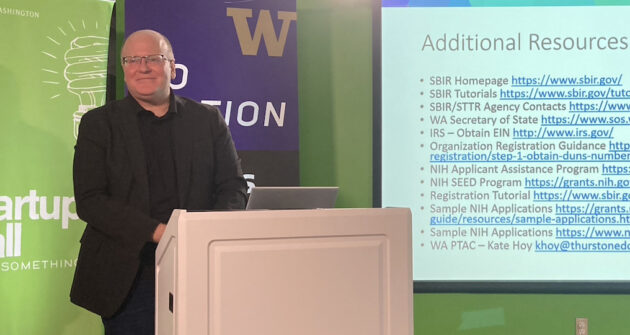
A good idea, preliminary data, and credentials in the field are all key components of landing a small business grant from the U.S. government to launch or expand a company.
“It’s all about the commercial potential,” said Richard Giersch, executive director of Life Science Washington Institute, at a recent talk at the University of Washington: “Fundamentals for startups: Demystifying federal funding opportunities.”
SBIR (small business innovation research) and STTR (small business technology transfer) awards account for the vast majority of U.S. government grants to small businesses, said Giersch. SBIR and STTR grants “are the largest form of non-dilutive funding in the world,” he said.
Over the years, SBIR and STTR grants have provided more than $1.6 billion to 4,577 Washington state companies, said Giersch. Washington recipients in 2023 include startups Histone Therapeutics, Phase Genomics and Talus Biosciences. Even Seattle-area biotech giant Seagen, which recently sold to Pfizer for $43 billion, landed SBIR grants in its early days.
SBIR/STTR grants can enable companies to take shape, prove the value of their technology, and set the stage for later funding from investors. “They are generally viewed as positive” by investors, said Giersch. “It is a de-risking.”
Dipping into the funding pool
The U.S. National Science Foundation and the National Institutes of Health are the biggest providers of SBIR/STTR grant funding in Washington state, followed by the U.S. Department of Energy, according to Giersch.
The Department of Defense and other U.S. agencies also fund SBIR/STTR grants, such as a recent SBIR grant to Seattle-area fusion company Avalanche Energy. Agencies set aside a percentage of their budget for the programs.
Phase I SBIR/STTR grants through NIH generally provide up to $307,000 for proof-of-concept and feasibility studies. Phase II NIH grants provide up to $2.05 million for further work like prototype development, field testing and early clinical studies.
The pool of money available for STTR grants is smaller, but they also receive fewer applicants than SBIR grants, said Giersch. STTR grants require that the business partner with a non-profit research institute and they have different rules about how much time academic principal investigators must spend with the company versus their institution.
“I’ve seen dozens of different scenarios,” said Giersch of how founders divide their time. He added that startups don’t need to have a full-time lab, an office or full-time employees to apply.
Both SBIR and STTR grants have an emphasis on first-time applicants and socially disadvantaged individuals, whether because of race or ethnicity, or attributes like a rural location. The programs also encourage participation by majority-women owned businesses.
Though Giersch’s talk focused mainly on SBIR/STTR grants, European and Israeli organizations also offer grants to partnered businesses and universities in the U.S., he said.
Giersch and his colleagues advise startups on snagging small business grants as part of Accelerating Research and Commercialization – Washington (ARC WA) — launched in 2022, with a U.S. small business administration grant. Life Science Washington Institute is a partner in the program along with Washington APEX Accelerator, which provides government contracting assistance to Washington state firms.
Read on for some of Geirsch’s advice on how to write and land an SBIR or STTR grant. His talk was sponsored by the UW’s commercialization office, CoMotion, and is available for viewing in the video below.
Plan lots of lead time
Giersch advises applicants of phase I grants to get started at least 10 weeks before the due date. Applicants should make time to identify two to three external reviewers and to meet with the granting program officer.
Even before starting to write, applicants should complete the various online federal small business registration requirements, “These can be a bit of a thicket,” and could require months to get right, warns Giersch. ARC WA can help, he adds.
Get budgeting right
“Make sure you give a robust budget justification. Always err on the side of giving too much information,” said Giersch. If applicants provide vague budget information or include items not included under the grant funding, their budget will be cut. “The program officers and the budgeting officers are very literal,” added Giersch.
Be precise about addressing the agency’s criteria
The application is only six pages, plus supporting documents and one page of specific aims. But reviewers typically read piles of them.
“Understanding the evaluation criteria and calling them out makes the reviewers’ life simple,” said Giersch. As a reviewer, Giersch appreciates applicants providing guideposts in their writing, like pointing out exactly how a project is innovative and noting it with language like, “this project is innovative because…”
Provide a thorough literature review
Make to cite all key papers — external reviewers can balk if their own work is not noted, said Giersch. It’s great to include your own research papers to justify your application, but publications are not necessary, he said: “It’s more about the preliminary data.”
Write your own technical section
Grant consultants can be helpful but turning the bulk of technical writing over to them is “usually a mistake,” said Giersch. “You are the technical expert. Doing it yourself is almost always more convincing to the readers,” he said.

